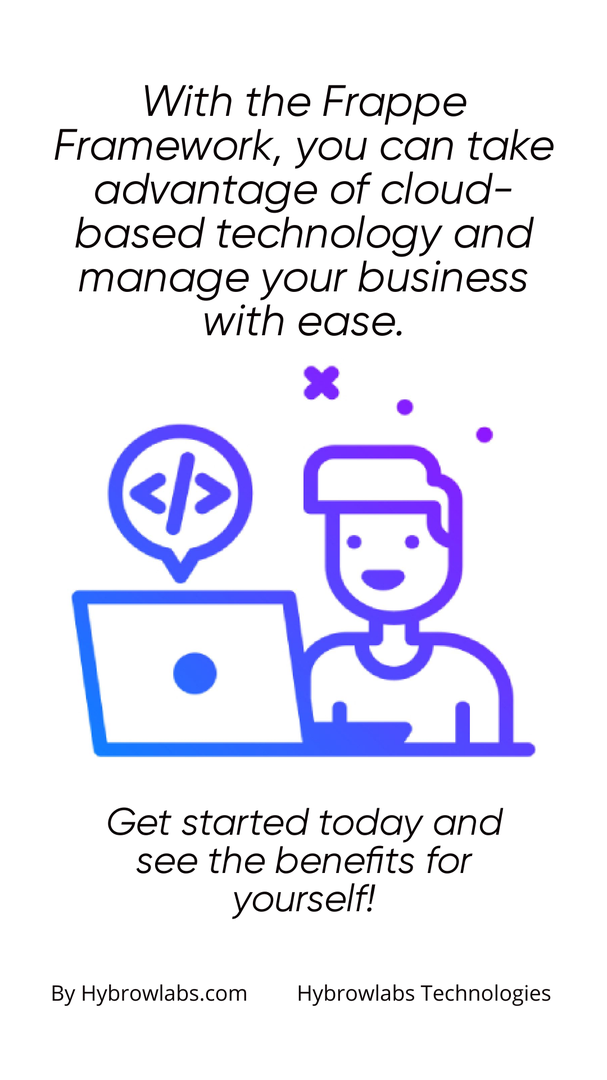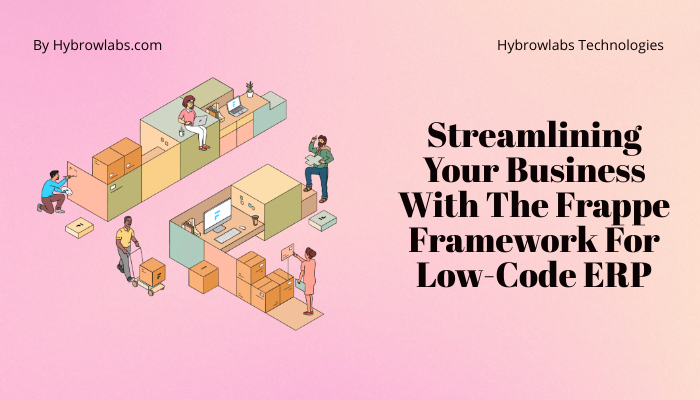In the world of enterprise resource planning (ERP) systems, low-code platforms are becoming increasingly popular due to their ability to streamline business processes & reduce the amount of custom coding required. One of the most innovative open-source ERP solutions is the Frappe Framework, which has the potential to transform the way companies manage their operations. Here's a detailed guide on how to streamline your business with the Frappe framework for low-code ERP.

The Difference Between “Closed” vs Open Source Low-Code Platforms:
Low-code platforms come in two different forms: closed & open-source. Closed-source platforms are proprietary software products that are only available through the vendor. On the other hand, open-source platforms are freely available for anyone to use, modify & distribute, which makes them more flexible & customizable.
What are the Pros & Cons of Open Source Low-Code Platforms?

Open-source low-code platforms offer several advantages over their closed-source counterparts. Firstly, they are more cost-effective because there are no licensing fees or vendor lock-in. Secondly, open-source platforms have a large community of developers who contribute to the platform, which means that bugs are fixed more quickly, & new features are added regularly. Thirdly, the source code is available for developers to customize, which provides greater flexibility.
However, there are some downsides to open-source low-code platforms that companies should be aware of. Firstly, there is a learning curve involved in using & customizing the platform. Secondly, open-source platforms are not always as well documented as proprietary software, which can make it more challenging for companies to adopt them. Lastly, open-source platforms may lack some features that are available in proprietary software.
Let’s Talk About These Advantages:

One of the biggest advantages of the Frappe Framework is its open-source nature. Companies can use the platform for free & customize it to meet their specific needs. Additionally, the Frappe Framework has a large community of developers who contribute to the platform, which means that bugs are fixed quickly, & new features are added regularly.
Another advantage of the Frappe Framework is its user interface, which is intuitive & easy to use. This means that companies can train their employees on how to use the platform quickly, reducing the amount of time & resources required for onboarding.
The Downside Facts That You Should be Aware of:
While the Frappe Framework offers many advantages, there are some downsides that companies should be aware of. Firstly, the platform has a learning curve involved in using & customizing the platform, which can be challenging for some companies. Secondly, the platform may lack some features that are available in proprietary software.
Compare the Top Free ERP Software of 2023:
1. YetiForce CRM:
An open-source ERP system that supports inventory management, project management, sales & purchase, & help desk functionalities.
2. WP ERP:
A cloud ERP solution that provides project management, HR management, & CRM features.
3. ERP Gold:
An open-source ERP system that supports inventory management, accounting, & human resources.
4. Cetec ERP:
A free version of the Cetec ERP software that includes manufacturing, inventory management, & customer relationship management (CRM) features.
5. OpenPro ERP:
An open-source ERP system that supports inventory management, project management, accounting, & eCommerce.
Modules & Features List:
1. Sales & Purchase:
The sales & purchase module tracks sales orders, invoices, payments, & purchase orders.
2. Project Management:
The project management module includes task management, project timelines, project budgeting, & resource allocation.
3. Help Desk:
The help desk module manages customer support inquiries & tracks ticket resolution.
4. Asset Management:
The asset management module manages company assets, including maintenance & depreciation schedules.
5. Website Management:
The website management module enables businesses to create & manage their websites, including eCommerce features.
Implementing Premise-Based ERP:
When implementing a premise-based ERP system, businesses should conduct a thorough process review, stand by requirements, & examine & certify the vendors. Additionally, businesses must ensure that the ERP system aligns with their organizational objectives.
Frappe – The Basics First:
Frappe is an open-source low-code platform that provides a framework for building ERP systems. The Frappe framework enables businesses to build customized ERP solutions that cater to their specific business requirements.
1. Frappe Technology
The Frappe technology includes the Frappe framework, which is a Python-based web application framework. The framework supports a modular architecture & follows a metadata-first approach, which means that the application's structure & behavior are defined in metadata rather than in code.
2. Frappe Framework
The Frappe framework is designed to be highly extensible & customizable, enabling developers to create ERP solutions that are tailored to their businesses' specific requirements. The framework also provides a user-friendly interface that simplifies ERP development.
3. Frappe Environment
The Frappe environment includes all the tools required to build, deploy, & manage ERP applications. The environment supports development, testing, & deployment, & provides tools for code management, version control, & collaboration.
Streamlining Your Business With The Frappe Framework For Low-Code ERP:
In today's fast-paced business world, streamlining operations & increasing efficiency are critical to staying competitive. This is where the Frappe framework comes in handy. The Frappe framework is an open-source low-code platform that can help businesses streamline their operations, reduce costs, & increase productivity.
1. Batteries Included in ERP:
The Frappe framework is a full-stack web framework that comes with many batteries included. It has everything you need to build & deploy a low-code ERP system. Everything is included in the framework, from the user interface to the database. This makes it easier & faster to build ERP systems.
2. Metadata First:
In the Frappe framework, metadata is king. The framework allows you to define your data structure using metadata. This means that you can define your data structure without writing any code. This is a huge advantage when it comes to building & modifying ERP systems.
3. Admin User Interface:
The admin user interface in the Frappe framework is designed to be easy to use & intuitive. It allows you to manage your ERP system from a single dashboard. This includes managing users, roles, & permissions, as well as configuring email settings & managing jobs.
4. Roles & Permissions:
The Frappe framework has a robust role-based permission system. This means that you can define what users can & cannot do in your ERP system. You can also define roles & permissions for different departments & teams within your organization.
5. REST API + Webhooks:
The Frappe framework comes with a REST API that allows you to integrate your ERP system with other systems. It also has webhooks that allow you to trigger actions based on specific events. This makes it easier to automate your workflows & reduce manual work.
6. Job Scheduler:
The job scheduler in the Frappe framework allows you to schedule jobs to run at specific times or intervals. This includes sending emails, generating reports, & running background tasks. This can help you automate many tasks & reduce manual work.
7. Email Setup:
The Frappe framework allows you to configure email settings for your ERP system. This includes setting up email servers, email templates, & email notifications. This can help you automate many tasks & reduce manual work.
Rapid Application Development:
The Frappe framework is designed for rapid application development. This means that you can build & deploy ERP systems quickly & efficiently. This can help you save time & reduce costs.
Learn Frappe Framework:
If you want to learn more about the Frappe framework, there are many resources available online. The Frappe framework website has documentation, tutorials, & a community forum. There are also many third-party resources available online.
Conclusion:
Streamlining business operations is crucial for success, and one way to achieve this is through the use of the Frappe framework. This low-code ERP solution provides inventory management, project management, and user-friendly interfaces, making it an ideal solution for businesses of all sizes. With cloud ERP capabilities and free ERP versions available, Frappe is a powerful tool for streamlining business processes. To fully utilize the capabilities of Frappe, businesses can turn to the ERPNext development services offered by Hybrowlabs. With their expertise in ERPNext development and customization, Hybrowlabs can help businesses fully integrate Frappe into their operations. Additionally, Hybrowlabs also provides Manufacturing ERPNext Services for businesses looking for specialized support in managing their manufacturing processes. With their experience and knowledge, Hybrowlabs can help businesses achieve their goals through the power of Frappe and ERPNext.
FAQ:
1. What is the Frappe Framework for Low-Code ERP?
The Frappe Framework is an open-source platform that allows businesses to build customized ERP systems with ease. The framework provides a low-code approach to software development, which means that users can create & deploy applications without having to write extensive amounts of code. With the Frappe Framework, businesses can quickly develop ERP solutions that meet their specific needs.
2. What are the benefits of using the Frappe Framework for Low-Code ERP?
The Frappe Framework offers numerous benefits to businesses. One of the most significant advantages is that it provides a free ERP solution that can be customized to fit the specific needs of a company. The platform also includes features like inventory management & project management, making it a comprehensive ERP system. Additionally, the Frappe Framework's open-source nature means that users have access to the source code, allowing for even more customization.
3. How does the Frappe Framework compare to other ERP systems?
Compared to other ERP systems, the Frappe Framework is unique in its low-code approach to development. This approach allows for quicker development times & greater flexibility in terms of customization. The platform is also open-source, meaning that it is free to use & can be modified by anyone. Additionally, the Frappe Framework offers a user interface that is both intuitive & easy to use, making it accessible to businesses of all sizes.
4. How does the Frappe Framework handle cloud ERP?
The Frappe Framework is a cloud-based ERP system that can be hosted on a variety of platforms. Users can deploy the system on cloud servers like AWS or Google Cloud, making it a flexible solution for businesses that want to take advantage of cloud-based technology. Additionally, the Frappe Framework offers built-in security features to ensure that data is protected when it is stored in the cloud.
5. How do I get started with the Frappe Framework?
Getting started with the Frappe Framework is easy. The first step is to visit the official website & download the software. From there, users can follow the installation instructions provided by the platform to set up their ERP system. Alternatively, businesses can work with a partner like Sync Bricks or ERP Research to install & customize the Frappe Framework to fit their specific needs.






a3dc85.jpg)
.jpg)
fd8f11.png)


.jpg)
.jpg)